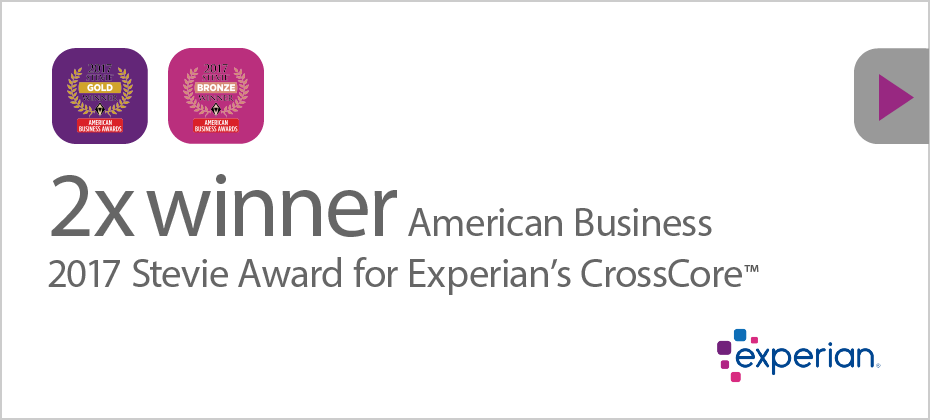Innovation
At Experian, we are continually innovating and using technology to find solutions to global issues, modernize the financial services industry and increase financial access for all. Read about our latest innovation news below:

A core theme of the European Union’s General Data Protection Regulation (EU GDPR), which is to keep consumer interests front of mind at all times, mirrors sound fundamental advice for all companies. Customer centric business practices are especially essential in the data-driven age, driving innovation and opportunity. The transparent, secure and effective use of data has transformative potential for consumers and businesses. But consumers must feel comfortable and in control of its opportunities, and there is a clear role for our industry to play in addressing their understandable concerns around privacy and security. In particular, there is a need for more openness about how data is collected and used for the benefit of consumers. In business, we are all aware of the advantages that data-driven technology can bring. Yet the way data is harnessed for good hasn’t, to date, been central part of the prevailing ‘data narrative’. At Experian, we process over 1,151 billion records a year, with a global segmentation of more than 2.3 billion consumers in more than 30 countries, and demographic data on over 700 million individuals and 270 million households combined. It’s a responsibility we take very seriously. We have always aspired to set new benchmarks for best practice in our operating standards and our approach to data stewardship. As a trusted data custodian for millions of consumers, we aim to unlock the power of data to create opportunities for individuals, businesses and society. The world is becoming more connected every day, and if businesses are serious about keeping up with the change, a truly holistic approach to managing all this data is required. One which protects our customers and our products from risks, such as an ever-increasing array of cyber threats, while ensuring the customer journey is as relevant and fluid as it needs to be. To help businesses to start thinking about how they can survive and thrive in the new regulatory environment, we’ve created a new whitepaper, ‘Defining the Data Powered Future’. It sets out some key steps that business should consider working through, our three ‘I’s – “Investigate”, “Improve” and “Integrate”. Businesses need to start to thinking about their implementation requirements now, if they haven’t already. And we hope this paper will offer some food for thought. It’s not good enough to feel ‘fairly confident’ that the data held is being used in the interests of the customer. It’s a requirement that new levels of scrutiny are applied here, and the customer’s perspective is the be-all and end-all guide to whether you are getting it right. With the advent of GDPR, this type of joined-up thinking will need to become the new normal, as the “datafication” of our world continues. I would encourage businesses of all shapes and sizes to take the opportunity that this moment brings. Now is the time to create a truly consumer-centric approach to data governance and strategy, and to secure your customer’s place at the heart of your data powered future.

Organizations everywhere are looking to do more with their data assets, as well as better leverage open data and third party data sources for additional consumer insight. The good news is that there is no shortage of information available. The bad news is that wrangling and making sense of all that information can be very challenging. That is why we see 61 percent of U.S. companies stating inaccurate data is undermining their ability to provide an excellent customer experience. However, there is a new breed of data professionals trying to change all that. New talent is coming into organizations looking to unlock the power of data to transform business operations and better serve clients. Businesses everywhere are eager to bring on these data professionals; to the point it is creating a frenzy around data staffing. If you are looking to hire new data professionals, you are certainly not alone. According to a new Experian Data Quality report, Investing in Digital Transformation: This Year’s Most Sought-After Data Roles, businesses are hiring a mix of business- and regulation-focused data positions. Below is a chart showing the top roles being hired according to U.S. respondents and also c-level executives specifically: There are a few key roles I want to highlight. First, data analysts. They are the most sought-after data role by U.S. organizations, mainly because they are so versatile. They are individuals placed across departments to analyze data in such a way that it can be used for business intelligence. 57% percent of businesses spend a majority of their time analyzing data, and this role is key to ensuring they’re getting the right results. The most important role for c-level executives is the chief data officer (CDO). The CDO has seen a lot of hype in the past few years and at this point we are seeing more general adoption of the role. This individual is responsible for developing and implementing an information strategy, which includes disciplines like data security, governance, quality, and management. They also will oversee a team of data professionals who bridge the gap between the business and IT. We have more research on this role in particular coming out next month, but they will often shape cross-functional data organizations and how well businesses can achieve the data insight they desire. In general, with all of these roles, talent shortages are a problem. Relative to demand, very few experienced individuals exist on the market. This means organizations need to come up with creative ways to attract and maintain this talent to keep up with the changing business landscape. For more information on these and other data roles, download a copy of our new report: Investing in digital transformation: This year’s most sought-after data roles. Download the complete "The Year's Most Sought-After Data Roles" report.

The real-time economy is all around us. With the swipe of a finger, we can order a car, find a babysitter or make a mortgage payment.

Believe it or not, my personal journey as a woman in data science started with physics. I was always very curious by nature and tried to understand what happens around me. I studied for both a master’s in physics in Spain and a Ph.D. in astrophysics in the Netherlands before making my shift from academia to industry (first in a Big Four consultancy and later in Experian). Gradually, I realized that I liked the academic side of working with data and applying the scientific method to solving problems, but I wanted to do something faster-paced that had more tangible impact. So, before finishing my Ph.D., I joined a data boot camp to further develop my skills, and after defending my thesis I transitioned to data science. Now I’m a full-fledged data scientist at Experian DataLabs. The world is at a very interesting time in terms of technology and innovation, and STEM fields are only going to continue growing. As a data scientist myself, I may be biased, but I think the future of this field is particularly interesting. I can see data being applied in such a variety of ways – from self-driving cars to early medical diagnoses and beyond. In fact, I don’t see the momentum slowing down any time soon, which means that data scientists will continue to be in high demand. I want to do something about the disproportionate amount of men to women in science, showing girls that STEM is for them, too. There’s no quick-fix solution, but I think it’s essential to start educating girls when they’re young about STEM – both at home and in school. Young girls should be encouraged to be curious, to try and fail! For me, data science isn’t about getting it right the first time; it’s about the path of discovery and innovation along the way. The sooner and the longer that girls are encouraged to explore and play with less-conventional toys, like computer games, construction toys or logic puzzles, the likelier they may be to choose careers based on what they personally enjoy doing and not what society expects them to do. Gender stereotypes can be really constraining, especially for children. So, what can a diverse workforce offer that a narrow one can’t? The answer is easy: different approaches, different views and different solutions. With more women in fields like data science, everyone benefits. No one should have to automatically rule themselves out of a career path based on gender.

For any company to remain competitive in today’s rapidly changing marketplace, innovation must play an integral role in its business model. Industry’s greatest innovators are successful not only because they deliver superior products in the present, but also – and perhaps more importantly – because they continuously solidify their place in the future through a culture of discovery that encourages modernization and disruption. The amount of data is expected to increase up to ten times the current amount by 2020, and Experian looks to innovation to bring answers to the problems such increases can pose. We’re finding new ways to help business across a multitude of industries integrate the latest in data technology into nearly every aspect of their operations. Data is powering everything we do. A great example of our commitment to continuous improvement through innovation is Experian’s DataLabs operation, which Greg Satell profiles in his new book Mapping Innovation: A Playbook for Navigating a Disruptive Age. At Experian, we saw opportunity to innovate and adapt, and proposed the creation of a separate division with the sole purpose of pursuing disruptive opportunities where there was no existing market to measure – we called it DataLabs. As Satell notes, Experian DataLabs was designed to work with our customers to map out their problems, identify new opportunities, build solutions around those opportunities and develop new capabilities for the company. With an increasingly competitive market, Experian is committed to being inventive and agile. Embracing and sustaining this innovation has worked. In the United States alone, DataLabs has launched eight products, and has another twelve in development. We continue to work with our customers to address new problems and remain agile so we can develop new capabilities. These insights have real world application that can help tens of thousands of Americans. As an example, small businesses - the classification of businesses that create nearly two-thirds of net new jobs in the United States - notoriously struggle to obtain loans to grow because of a perceived lack of data on their credit worthiness. Without access to credit, these businesses aren't able to grow further, preventing them from hiring more people. DataLabs' latest experiment concerned whether social media sites can help businesses obtain credit. By looking at social media sites we were able to help small businesses with credit verification. DataLabs also works to help companies more efficiently use resources to target the right consumer. As an example, Experian's DataLabs scientists analyzed billions of credit and debit card transactions to understand how population segments spent money and then used that information to build predictive behavior profiles. With this information in hand, credit card companies were able to market credit cards to specific population segments and make rewards programs more attractive to consumers in the process. Perhaps more importantly, though, DataLabs ensures that Experian has a place in tomorrow’s economy by keeping Experian relevant in an ever-evolving marketplace. To quote Satell, “every enterprise is a unique combination of business model, strategy and culture.” Experian is the manifestation of a culture of discovery that enables us to grow and evolve while remaining at the forefront of innovation. Experian’s innovations continue to be recognized and we are proud to be included in Greg Satell’s insightful book. To read the complete profile of Experian, including more information on its formation, work to-date and plans to continue disrupting the future, check out Mapping Innovation: A Playbook for Navigating a Disruptive Age here.

"If you’re taking an emergency call (999 in the U.K.), it’s easy to spell a name wrong. And sometimes people reporting a crime won’t give you their name at all. So, after 13 years, we’d collected thousands of duplicate or incorrect records. That might seem trivial, but linking data with the right person can be crucial to a case. You might speak to a vulnerable person and miss that they’re a repeat victim of crime. The bottom line is that, to keep people safe, we needed better data. I asked Jon (at Experian) if he could help. He certainly could. I applied for Home Office funding for the project and, after three nerve-wracking months, we actually won it. Then it was, ‘Alright, how’s this going to work?’. Experian set up a system for us called Pandora. It took our data, cleansed it using Experian data – filling in gaps, adding data streams so that, using our own matching criteria, we managed to merge thousands of records. The result was data that’s as clean and accurate as we could possibly get it. We call it our Golden Nominal database -- and the difference is phenomenal. Now, incoming calls prompt one or two records instead of hundreds, giving us a clear view of the caller. If someone’s calling about domestic violence, we’ll see whether they’re a repeat victim, and get them help fast. And frontline officers can run instant checks on a suspect from a phone, seeing how big a risk they pose and whether to call for support. We’ve got a way to go, but we’re already creating a thousand fewer records a week. And it’s all down to Experian’s work behind the scenes. It’s delivering exactly what we wanted."

I’m constantly amazed at how Experian gets to uncover and bring to life the data that really matters. By partnering with the National Literacy Trust to analyze different data sets, we uncovered a widespread literacy crisis in England. A while back, Experian was approached by the National Literacy Trust in England, asking us to collect information to help them better understand how far-reaching literacy problems are in England. Using data from Experian, the National Literacy Trust and the 2011 census, our data analytics team compared data sets against social factors that are closely associated with low literacy levels, such as education, income and unemployment rates. Through this in-depth analysis, we were able to create a literacy vulnerability score for every single electoral ward and parliamentary constituency in England. We found that 86 percent of all English constituencies have entrenched problems with literacy. What was most surprising was how far-reaching the problem was across the country. I guess I had assumed, as most would, that in the more affluent areas where there are good levels of education, higher incomes and higher employment rates, children would have a good relationship with books. We found, however, that it doesn’t matter what community you live in, or how affluent or deprived the area is – literacy issues can affect all of us. While the initial reaction by the public has been one of shock, I really think this study was something England needed to help the next generation avoid the same problems. Working alongside the National Literacy Trust, we’re leveraging this data to raise awareness within the government. Early in February 2017, we supported an event for Members of Parliament (MPs) to highlight how the issue may affect their constituencies, using a ranking table that shows which areas are the most affected. You could say this literacy issue is a bit of a crisis, and MPs would now agree. In my role at Experian, I frequently look at what we call “societal impact stories” that highlight how Experian is engaged in local communities. What I love about my job is getting to see how all the powerful information we have on hand is being used to lay the foundations for others to transform lives and local communities for the better. While there is still much work to be done to solve the literacy issue in England, I’m constantly amazed at how we at Experian get to uncover and bring to life the data that really matters.

Bernard Marr, who LinkedIn recently ranked as one of the top 10 business influencers in the world (just behind Bill Gates and Richard Branson), recently published a story on Forbes about how Experian is using machine learning to cut mortgage application times to just a few days. In this article, Experian’s Global CIO, Barry Libenson, discusses how Experian is well-positioned to pioneer technology in this field, due to the fact that banks, insurers and public sector bodies all routinely come to it for its data. “Now the large financial institutions don’t want you to dictate to them how they consume information, they want to tell you how they want to consume it, and you have to deliver it to them in that way. So they can say ‘hey, Experian, we have a simple question we want to ask and we expect a simple response, and we want it in real-time, and we want to be able to get it 24 hours a day from anywhere in the world.'” Check out the full article: How Experian Is Using Big Data and Machine Learning to Cut Mortgage Applicatoin Times To a Few Days

We developed CrossCore to make the industry’s fraud and identity solutions work better for everyone. We wanted to help organizations prevent more fraud while making it easier for their good customers to do business with them and nearly a year after the launch we’re proud of the reception we’ve had from clients, partners and the industry. Our latest honor is a bronze and gold medal from the American Business Awards for Identity and Access Security Solution Product of the Year and Product Management Department/Team of the Year. “We developed CrossCore to help our clients get the strength they want with the flexibility they need for more effective fraud management,” said Kathleen Peters, Global Vice President, Product Management, Fraud and Identity at Experian. “These latest Stevie Awards validate the feedback we’ve received from the market, and more importantly, from our clients.” CrossCore helps organizations with the ever-changing, complex and challenging world of fraud prevention. Businesses readily add solutions from us, other providers, and even their own solutions, to connect, access and orchestrate decisions across multiple systems. To make this possible for our clients, our teams worked around the clock in offices all around the world. They brought experiences and perspectives together to build and test code in packages that could be installed anywhere and everywhere. Using this “immutable infrastructure” approach, the team built, configured, connected, tested and monitored over 20 different systems to ensure everything was working. And they did it in less than nine months. The Stevie Award judges recognize the efforts of this team and the power of CrossCore. Here are just some of the positive comments we received: “The deployment of a global project such as CrossCore in only 9 months is remarkable, especially with 20 different systems being interconnected to deliver the service. Lots of hard work from the team, congrats!” “Seems like the strongest and the best solution in fraud prevention. Experian is already the industry leader in its respective industry, however CrossCore seems to be a great service, with a beautiful and intuitive UI.” “A good write up on what appears to be a useful platform. This is a great accomplishment and the nomination sounds like a talented team of product developers and software engineers.” “Congratulations on delivering an ambitious product in a relatively short timeframe!” We’re excited about how CrossCore could fit into your fraud strategy and would love to talk to you about it. Learn more ways CrossCore can help your business prevent fraud.